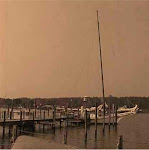June 2010
The heart of the problem with the skipjack the Dee of St. Mary's was diagnosed last fall as rotten wood in her keel. Fresh water is what rots wood. Salt water preserves.
The extent of the rot in the keel was uncovered last week.
The inboard portion of the keel -- in the stern -- consists of a laminate of three chunky three-inch by ten-inch boards. The laminated keel runs from the stern forward about 12 feet to midship. From that point forward the Dee's keel becomes a single piece of 12 by 12 fir shipwright Francis Goddard had shipped from Oregon.
The laminate is described in the video piece by piece -- the center keel, right (or starboard) cheek and left (port) cheek. A substantial length of the right cheek had to be removed and a portion of the center keel as well.
The rot does not extend into the left cheek or below the hull planking. Nor is there any rot in the lower keel, the portion extending beyond the bottom of the boat or in the skag, the sternward extension of the keel for the mounting of the rudder.
Rotten wood found elsewhere is also being removed including segments of the deck, some hull planks and the entire forward cabin.
Shipwrights start arriving at 7 a.m. with the intent to remove all bad wood and permit the fullest exposure to U. S. Coast Guard inspectors due for an on-site inspection this week.
Subscribe to:
Post Comments (Atom)

No comments:
Post a Comment